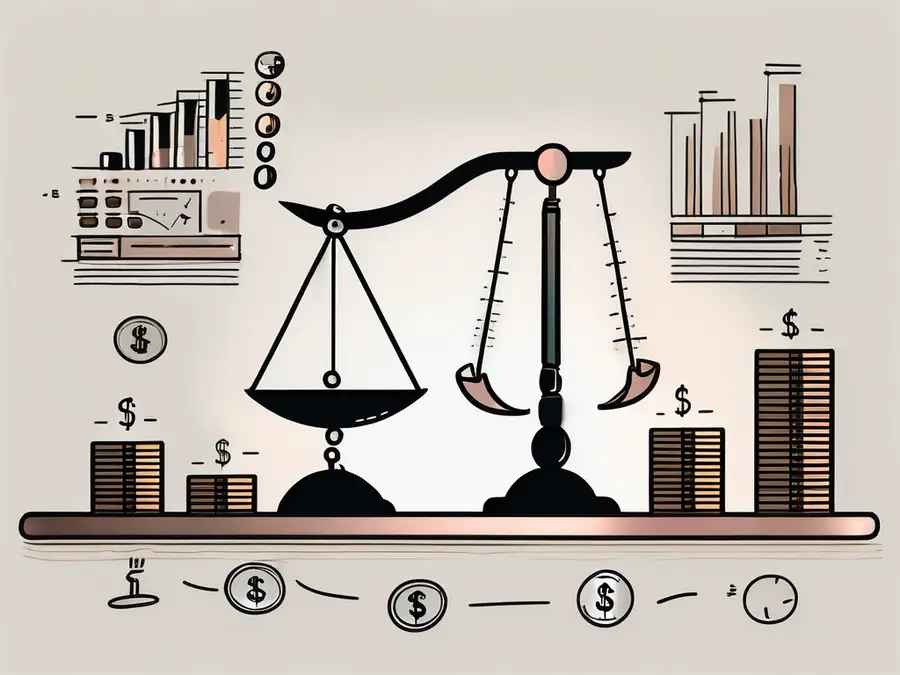What Does WACC Tell Us?

Welcome to my article on the concept of Weighted Average Cost of Capital (WACC). As an expert in finance and investment, I am excited to shed light on what WACC is and what it can tell us about a company's financial position. WACC is a fundamental tool used by analysts and investors to assess the financial viability of a company and make informed investment decisions.
Understanding the Concept of WACC
WACC is a financial metric that represents the average cost of capital for a company. It takes into account the cost of both debt and equity financing and calculates the weighted average of these costs based on the proportion of each in the company's capital structure. WACC is expressed as a percentage and is used as a discount rate in various financial analyses, such as valuations and capital budgeting.
The Components of WACC
WACC is composed of two main components: the cost of debt and the cost of equity. The cost of debt refers to the interest expense a company incurs on its outstanding debt obligations. It is calculated based on the interest rate on the company's debt instruments, taking into account factors such as credit risk and market conditions.
The cost of equity, on the other hand, represents the return expected by equity investors who provide capital to the company. It takes into consideration the risk-free rate of return, the company's beta or systematic risk, and the equity risk premium.
The Importance of WACC in Financial Analysis
WACC is a crucial tool in financial analysis for several reasons. Firstly, it helps determine the minimum return a company needs to generate to cover its capital costs. If a company cannot generate returns higher than its WACC, it may struggle to attract investors or may not be creating value for its shareholders.
Secondly, WACC is used to estimate the value of a company by discounting its expected cash flows. By using WACC as the discount rate, analysts can arrive at a present value that reflects the company's risk profile, projecting its future profitability.
Lastly, WACC assists in determining the optimal capital structure for a company. By analyzing the cost of debt and equity, management can make informed decisions on how much debt and equity to use in funding their operations and investments.
Calculating WACC: A Step-by-Step Guide
Now let's dive into the practical steps involved in calculating WACC.
Determining the Cost of Equity
The cost of equity is calculated using the Capital Asset Pricing Model (CAPM), which takes into account the risk-free rate, the company's beta, and the equity risk premium. The risk-free rate represents the return on a risk-free investment, such as government bonds. The company's beta measures its sensitivity to market movements, amplifying the systematic risk. Lastly, the equity risk premium compensates investors for taking on equity risk compared to risk-free investments. By plugging in these variables, we can calculate the cost of equity.
Determining the Cost of Debt
The cost of debt can be calculated by taking the average interest rate a company pays on its debt or by using the yield on comparable bonds. It is crucial to consider factors like credit ratings, market conditions, and the company's financial health when determining the cost of debt. It is important to note that interest expenses are tax-deductible, reducing the effective cost of debt.
Calculating the Proportions of Debt and Equity
The next step is to determine the proportion of debt and equity in the company's capital structure. This can be achieved by dividing the market value of each component by the total market value of the company's debt and equity. This calculation provides the weights required to calculate the weighted average cost of capital.
Interpreting WACC Results
Once you have calculated the WACC for a company, it is vital to understand what the results signify.
What a High WACC Indicates
A high WACC indicates that the company has a higher cost of capital, which means it needs to generate higher returns to justify its investments. This could indicate higher risk, potential difficulties in accessing affordable funding, or an inefficient capital structure. A high WACC can also impact the valuation of the company, indicating a higher discount rate for projected cash flows.
What a Low WACC Indicates
Conversely, a low WACC suggests that the company has a lower cost of capital, meaning it can generate value with less risk. A low WACC may be an indicator of a favorable credit rating, efficient operations, or a well-structured capital base. However, a very low WACC should be scrutinized to ensure it is not a result of unrealistic assumptions or flawed calculations.
WACC and Investment Decisions
WACC is an essential tool in making investment decisions and evaluating the financial feasibility of projects.
Using WACC in Capital Budgeting
When analyzing potential investments, analysts compare the expected return on investment to the company's WACC. If the expected return is higher than the WACC, the investment is considered attractive and may create value for the company. Conversely, if the return is lower than the WACC, the investment may not be viable.
WACC and the Discount Rate
The WACC serves as the discount rate when calculating the present value of expected cash flows. By discounting future cash flows using the WACC, analysts can estimate the fair value of an investment or determine the value of a company.
Limitations of Using WACC
While WACC is a powerful tool, it is essential to be aware of its limitations.
Assumptions in WACC Calculation
Calculating WACC requires making several assumptions, such as the company's capital structure, cost of debt, and cost of equity. These assumptions may change over time and can impact the accuracy of the calculated WACC. It is important to regularly review and update these assumptions to ensure the relevance of the WACC calculation.
WACC and Risk Assessment
Although WACC considers the risk profile of a company, it does not capture all types of risk. For example, WACC does not factor in geopolitical risks, industry-specific risks, or company-specific risks that may affect a company's financial performance. To mitigate this limitation, analysts often supplement WACC with additional risk assessments.
As an expert in finance, I have come to appreciate the importance of WACC in assessing a company's financial viability and making informed investment decisions. It provides crucial insights into a company's cost of capital, value creation potential, and risk profile. By understanding how to calculate and interpret WACC, investors and analysts can navigate the complex world of finance with confidence.
I hope this article has given you a comprehensive understanding of WACC and its applications. If you have any further questions or would like to share your personal experiences with WACC, feel free to refer to the FAQ section below or reach out to me directly.
Frequently Asked Questions
1. What is WACC, and why is it important?
WACC stands for Weighted Average Cost of Capital and represents the average cost of capital for a company. It is important because it helps determine the minimum return a company needs to generate to cover its capital costs and to estimate the value of a company.
2. How do you calculate WACC?
WACC is calculated by taking the weighted average of the cost of debt and the cost of equity, where the weights represent the proportion of debt and equity in the company's capital structure.
3. What does a high WACC indicate?
A high WACC suggests that the company has a higher cost of capital, indicating potential difficulties in accessing affordable funding, higher risk, or an inefficient capital structure.
4. What does a low WACC indicate?
A low WACC indicates that the company has a lower cost of capital, meaning it can generate value with less risk. A low WACC may indicate favorable credit ratings, efficient operations, or a well-structured capital base.
5. How is WACC used in investment decisions?
WACC is used in investment decisions by comparing the expected return on investment to the company's WACC. If the expected return is higher than the WACC, the investment is considered attractive and may create value for the company.
6. What are the limitations of using WACC?
WACC has limitations, including the assumptions made in its calculation and the fact that it does not capture all types of risk. Regular review and supplementation with additional risk assessments can mitigate these limitations.
Understanding WACC is just the beginning of making informed investment decisions. With Morpher, you can take your trading to the next level on a platform that's as innovative as your investment strategy. Experience zero fees, infinite liquidity, and the flexibility of fractional investing and short selling across a variety of markets. Ensure your safety with the non-custodial Morpher Wallet, and if you're ready to up the ante, leverage your trades up to 10x. Join a trading revolution that's built on the Ethereum Blockchain, offering a unique trading experience with Virtual Futures. Sign Up and Get Your Free Sign Up Bonus today, and transform the way you trade with Morpher.

Disclaimer: All investments involve risk, and the past performance of a security, industry, sector, market, financial product, trading strategy, or individual’s trading does not guarantee future results or returns. Investors are fully responsible for any investment decisions they make. Such decisions should be based solely on an evaluation of their financial circumstances, investment objectives, risk tolerance, and liquidity needs. This post does not constitute investment advice.

Painless trading for everyone
Hundreds of markets all in one place - Apple, Bitcoin, Gold, Watches, NFTs, Sneakers and so much more.

Painless trading for everyone
Hundreds of markets all in one place - Apple, Bitcoin, Gold, Watches, NFTs, Sneakers and so much more.









